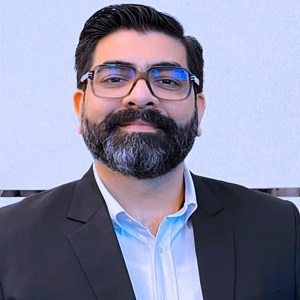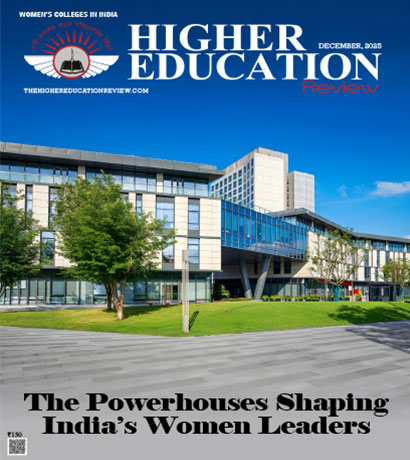Aligning Higher Education Curriculum with Industry Needs: Bridging the Skills Gap
 Gautam Duggal, Director Global Talent & Learning at Mastercard in an interaction with Higher Education Review, shared his views and thoughts about the current gaps between higher education curricula and industry demands. Gautam is a seasoned HR leader with over 20 years of experience. He has built and managed Talent & Learning HR teams from the ground up, driving success across medium-sized and large enterprises. His expertise spans core HR functions, including recruitment, leadership development, learning & development, career review, succession planning, business partnering, performance management, and organizational development interventions.
Gautam Duggal, Director Global Talent & Learning at Mastercard in an interaction with Higher Education Review, shared his views and thoughts about the current gaps between higher education curricula and industry demands. Gautam is a seasoned HR leader with over 20 years of experience. He has built and managed Talent & Learning HR teams from the ground up, driving success across medium-sized and large enterprises. His expertise spans core HR functions, including recruitment, leadership development, learning & development, career review, succession planning, business partnering, performance management, and organizational development interventions.
There is often a mismatch between the skills taught in higher education and those required by the industry, what are the current gaps between higher education curricula and industry demands?
Navigating the transition from college to the workforce can be challenging, particularly due to the gap between academic curricula and industry demands. One major gap lies in the rapidly changing technological landscape. While universities often focus on foundational theories, industries require proficiency in the latest technologies and tools, such as data analytics, cybersecurity, and AI. This means that graduates might need to catch up on practical skills that are immediately applicable in the workplace.
Another gap is in human skills, like communication, teamwork, and problem-solving. While technical knowledge is crucial, companies also value employees who can collaborate effectively, think creatively, and adapt to new situations. These skills often are not emphasized enough in traditional higher education settings. Moreover, many industries seek specific, hands-on experience, which is sometimes lacking in academic programs. Internships and project-based learning opportunities can help bridge this gap by providing real-world experience that complements theoretical learning. You should go for gig-assignments as well.
The job market evolves quickly, and industries value employees who are committed to continuous learning and development. I encourage all students to adopt a mindset of lifelong learning that can help them stay relevant and competitive.
In what ways can experiential learning opportunities, such as internships and co-op programs, be integrated into higher education curricula to better prepare students for real-world challenges?
Integrating experiential learning opportunities like internships and co-op programs into higher education curricula can significantly enhance students' readiness for real-world challenges. One effective approach is to build these experiences into the academic schedule throughout the program and allowing students to earn course credits for participating in internships or co-op placements. This ensures that hands-on learning is a fundamental part of their education, rather than an optional extra.
Universities should also collaborate closely with industry partners to create tailored programs that align with current market needs. This collaboration can lead to co-designed projects, where students tackle real industry problems, gaining valuable insights and skills.
Additionally, embedding project-based learning into courses can simulate real-world scenarios, encouraging students to apply theoretical knowledge to practical challenges. This might involve partnerships with local businesses or community organizations, offering students a chance to engage in meaningful work that benefits both their learning and the community. This is an excellent opportunity to pick up human skills.
Finally, providing strong support systems, such as career services and mentorship programs, can help students navigate these opportunities and maximize their learning experiences. By integrating experiential learning into the curriculum, universities can bridge the gap between academic knowledge and practical skills, better preparing students for successful careers.
How can involving industry professionals in curriculum design help create programs that are relevant, up-to-date, and capable of preparing students for real-world challenges?
Involving industry professionals in curriculum design is a powerful way to ensure that educational programs are relevant, current, and capable of preparing students for real-world challenges. By collaborating with experts who are actively engaged in the workforce, universities can gain insights into the latest industry trends, technologies, and skill requirements. This collaboration helps bridge the gap between academic theory and practical application.
Moreover, industry involvement can lead to the development of case studies, projects, and simulations based on real-world scenarios, giving students hands-on experience that mirrors actual work environments. Professionals can also guest lecture or conduct workshops, offering students direct exposure to industry practices and expectations.
By creating advisory boards or committees that include industry leaders, educational institutions can continuously update and refine their programs to stay aligned with evolving market needs. This dynamic approach not only enhances the curriculum but also strengthens the relationship between academia and industry, ultimately benefiting students, educators, and employers alike.
How does aligning higher education with industry needs present an opportunity to enhance diversity and inclusion, ensuring a broad range of perspectives and experiences in the workforce?
Aligning higher education with industry needs offers a significant opportunity to enhance diversity and inclusion in the workforce. By tailoring curricula to meet current market demands, educational institutions can attract a more diverse student body, including individuals from underrepresented groups who are eager to gain skills that lead to promising career paths.
When universities collaborate with industries to identify skills shortages, they can develop targeted programs that prepare students from diverse backgrounds for these roles, ensuring a wider talent pool. Industry partnerships can also facilitate mentorship and internship opportunities, providing students with real-world experiences and professional networks that might otherwise be inaccessible.
Moreover, emphasizing diversity and inclusion within these collaborative efforts ensures curricula incorporate varied perspectives and address the needs of all students. This approach not only enriches the educational experience but also prepares students to thrive in diverse work environments. Ultimately, aligning education with industry needs fosters a more inclusive workforce, reflecting a broad range of perspectives and experiences.
How can we prepare students to thrive in a global workforce by developing their cross-cultural competencies and adaptability to diverse working environments?
To prepare students for a global workforce, it's essential to develop their cross-cultural competencies and adaptability. Here are some tactical steps:
Cultural Awareness Courses: Integrate courses focused on global cultures, languages, and international business practices to broaden students' understanding of diverse perspectives.
Study Abroad Programs: Encourage participation in study abroad programs, which immerse students in different cultures and foster firsthand experience in adapting to new environments.
Diverse Team Projects: Assign projects that require collaboration with peers from various cultural backgrounds, promoting teamwork and communication skills across cultures.
Guest Lectures and Workshops: Invite industry professionals with global experience to share insights through lectures and interactive workshops, exposing students to real-world cross-cultural scenarios.
Internships with Global Companies: Facilitate internships or co-op programs with multinational companies, offering students practical experience in diverse work settings.
Language Proficiency: Encourage learning additional languages to enhance communication skills and cultural understanding.
By implementing these steps, students can build the necessary skills to navigate and succeed in a global workforce, equipped to adapt to diverse working environments.

